https://complexcareathomeforchildren.com
![]()
https://complexcareathomeforchildren.com
A key component of the pediatric approach is a 4 stage method (Anticipate, Prepare, Procedure, Recovery) that is very effective in helping children, of all ages, adapt to care needs. It can be used in the hospital, at home or in any other environment where care is being provided.
The pediatric approach is especially helpful with children who have care needs that are:
How does the pediatric approach work?
Parents and caregivers work as a team with their child with the goals of:
We recommend that you speak with your health care team if your child is showing signs of stress or any of the following:
Please don’t ignore these behaviours; if they are present, it is best for your child to deal with them sooner rather than later. Your child may benefit from the specialized services of a professional experienced in helping children develop coping skills, such as a nurse, child life worker, child psychologist or a physician. Learn more about specific behaviour problems, suggested do’s and don’ts here.
Read more here about the pediatric approach and how to use it with your child.
You and your child are a team! Children adjust to even very complicated care at home when they feel supported and safe. Invest in these tips to help your child avoid unwanted reactions such as: anxiety, stress or refusal of care.
A. Create the right moment
Integrate the care in a routine: for care that children need regularly, schedule the care so that it fits with your family’s routines as much as possible. Find specific tips in the section Prepare yourself, Organizing your day.
A predictable routine is soothing to children and helps them feel secure, for example: planning care after a calm game, before mealtime.
Aim to respect your child’s basic needs before doing a procedure, for example: offer a drink or snack, change diaper/have child use toilet, let your child have a nap if they are tired.
B. Alert your child to the needed care and communicate together
Depending on your child’s age and developmental level, let your child know that a specific care is going to take place. In general, younger children benefit from shorter times (minutes beforehand) between the “alert” and the procedure, while older children adapt better when they know further in advance that care will be provided (hours before hand). Ideally, when care becomes part of the family routine, children will easily know when it will take place.
| Infants | Toddlers | Preschoolers | School-aged | Adolescents |
| minutes | minutes | hours | hours | days |
This is a good time to prepare your child for what he/she can expect to happen next.
C. Form a team with your child
| Empower your child | = | Listen | + | Comfort and distract |
+ | Position |
To ensure comfort to help your child feel secure during treatments, you can mix a variety of strategies. You and your child can choose the strategies that fit best. As your child develops and grows, be prepared to try new strategies that reflect your child’s changing needs.
Encourage autonomy: Be aware of and offer realistic choices to your child. Letting your child decide is a key way to empower your child.
Stay tuned to your child: You know your child best. Try to anticipate your child’s reactions and encourage your child to express his/her feelings. Medical (therapeutic) play is an effective way to do this, to help your child adapt to the needed care.
For example, your child may wish to participate in the care or may be irritable or anxious prior to a procedure, or may try to delay the needed care in some way. Through medical play, you can allow your child to express these feelings and then respond to them in a simple, clear way.
Manage pain and anxiety: Each child is unique in their perception of pain and anxiety. Some children have more pain with repeated procedures and other children find the same treatment less painful over time. Behavioural techniques, such as using distraction and positioning can greatly increase your child’s comfort during procedures. If your child is still having discomfort, ask your health care team about other options, including medications or special creams that could minimize pain during home treatments.
A. Prepare the environment
Choose a place where care can be provided on a regular basis. Ideally, this location should be:
In advance, prepare the place where care will be given:
Before you position your child to receive the care, prepare anything else that can be done in advance. Organize your supplies and equipment, close at hand.
B. Prepare your child
| Get a helper, if needed | Position your child and prepare for distraction |
 |
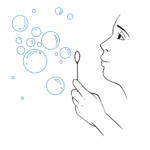 |
| Get the help of a 2nd person, if needed; otherwise minimize the number of people present, unless the child requests it. Make sure your helper knows how to help! Let your child know what the helper will do. Be specific in the tasks that you give to the helper. Provide feedback afterwards so that the helping can improve each time. | Position your child and begin to use the selected distraction method. |
C. Prepare yourself
As much as is possible, choose a time to give the care when you are focused, calm and well-rested.
| Review the list of care steps | Put on a mask (if required by the type of care or if you are sick) |
Wash your hands |
||
 |
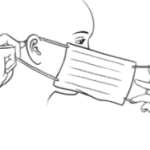 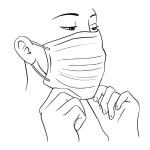 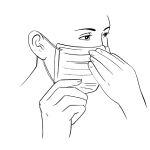 |
 |
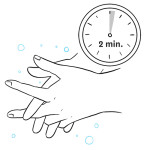  |
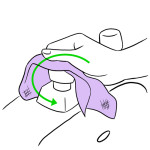 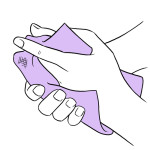 |
| Use a summary checklist. | Position the mask over the nose and under the chin. A standard mask should be changed every 30 minutes. | Remove jewelry. | Scrub well with soap for a minimum of 2 minutes. Rinse. | Dry your hands with a clean disposable towel and then shut off the tap using the towel. |
| **For care that requires sterile technique, open packages after washing your hands, just prior to starting the procedure. | ||||
Now that:
Take the opportunity to encourage and praise your child, especially recognizing choices that your child has made. Acknowledge and praise your child’s strengths and collaboration. For example “Thank you for holding your arm out, nice and straight. That will help the treatment go in easier. The pink pillow underneath that you chose is helping your arm feel comfortable. Good choice! Ready to watch the Dora video? You picked the episode where Dora goes to school – that’s one of my favourites too. Let’s turn it on.” (child could help, pushing the start button).

As you begin the procedure, carefully follow the steps that you have been taught. Work as a team with your child.
Keep in mind 3 key concepts:
The treatment is finished! Wash your hands again! It is important to “wrap up” on a positive note. Be prepared to recognize the challenges faced and also to provide positive feedback to your child, recognizing his/her strengths. Each time care is provided, you and your child learn how to improve the experience for the next time – that’s teamwork!
https://complexcareathomeforchildren.com/prepare-your-child/the-pediatric-approach/
Disclaimer of Liability: By using this site, you acknowledge that you have read this disclaimer and agree to all of its terms. Before making any decisions regarding your health or if you have any medical questions, you should first consult a physician or qualified health care professional who can provide recommendations tailored to your specific needs. The information published on this site does not constitute a recommendation for treatment (preventive or curative), a prescription or a diagnosis and is not a substitute for the advice of a physician or qualified health professional.
As medical and technical knowledge is constantly evolving, the content of this site is made available for information purposes only. The contributors to this site, including clinical experts in pediatrics from across Quebec, make every effort to ensure that the information made available on this site is as accurate and reliable as possible, without guaranteeing the completeness or total absence of error of its content. The opinions contained in this site are the sole responsibility of the author(s) and are not binding on the contributors to this site. These opinions do not necessarily reflect the official viewpoint of the organizations mentioned, nor that of their directors or representatives. The contributors to this site cannot and will not assume any responsibility for the use of the published content or for the information otherwise accessible through any link or reference source. Any quotation or reference to a source external to this site is for informational purposes only and does not constitute an endorsement or claim, express or implied, regarding the content or validity of the information obtained from that external source.
All rights reserved: The contents of this site may not be reproduced or disseminated, in whole or in part, in any manner or by any means, electronic, mechanical, including photocopying, recording, or otherwise, or stored in a retrieval system of any kind that is not limited to private use, without the prior written permission of the copyright holder.
Copyright © 2024 Soins Complexes. Tous droits réservés/All rights reserved.